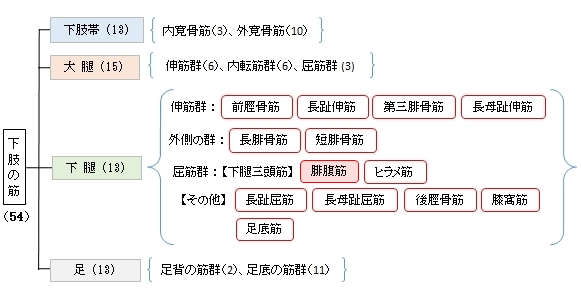腓腹筋 ( ひふくきん、英:gastrocnemius )
・ 概 要 |
・ 作 用 |
・ イラスト掲載サイト |
|
・ イラスト |
・ 神経 / 脈管 |
||
・ 起始 / 停止 |
・ Wikipedia |
![]()



・Wikipediaでは「距骨下関節」を含めて3関節筋としている。


腓腹筋とヒラメ筋の違い |
|||
腓腹筋 |
ヒラメ筋 |
||
1 |
筋の構成 |
速筋 が多い |
遅筋 が多い |
2 |
関節筋 |
単関節筋(足関節) |
|
「日本人体解剖学 (上巻)」には以下のような説明が見受けられる。
「外側頭が欠如あるいは痕跡的なことがある。腓腹筋に存在する種子骨および種子軟骨をファベラ(fabella)といい、通常円錐形を呈する。その発現頻度は男36%、女34%で、80%は両側性に見られる。長径は男9.2㎜、女8.4㎜、幅径は男7.5㎜、女7.1㎜、厚径は男5.6㎜、女4.4㎜である。」
「骨格筋の形と触察法」には以下のような説明が見受けられる。
「腓腹筋の起始は、大腿骨の遠位端から約5㎝頭方の部位であり、外側頭に比べて内側頭の方が若干頭方の部位から起こる。 ・腓腹筋は、大腿骨から直接起こる筋線維も多く、この部位の筋腹は半膜様筋と大腿二頭筋に覆われる。 」
筋連結 : 大腿二頭筋、大内転筋、長趾屈筋、ヒラメ筋、足底筋
以下は「船戸和也のHP」の解説になる。
「下腿後側の浅層の筋で、ヒラメ筋と合わせて下腿三頭筋と呼ばれる。大腿骨の内側上顆(内側頭)と外側上顆(外側頭)とから起こる。その停止腱はヒラメ筋とともに合流し、アキレス腱(踵骨腱)となり、踵骨隆起に停止する。踵骨後面の上部と踵骨腱が接近する部位には小さな滑液包が介在する。この筋は脛骨神経支配を受け、距腿関節による足の底屈、膝関節屈曲を生じさせる。Gastrocnemiusはフクラハギ(gastro-腹[腹のようにふくらむ]+kneme脚、スネ)」
![]()
![]()
【 起 始 】 : 内側頭 : 内側上顆(大腿骨) 外側頭 : 外側上顆(大腿骨)
【 停 止 】 : 踵骨隆起(踵骨) ※ヒラメ筋の停止腱とともにアキレス腱 《踵骨腱》となる。
![]()
「足を足底側に屈曲し、踵を上げ、膝関節を曲げる。足を固定するときは、下腿および大腿を後方へ引く。 」 ( 日本人体解剖学 )
![]()
・ 神 経 : 脛骨神経(L5,S1,S2) ※場合によってはL4を含む。
・ 脈 管 : 「後脛骨動脈」あたりだと思われるが、それに言及している資料は見当たらない。
The gastrocnemius muscle (plural gastrocnemii) is a superficial two-headed muscle that is in the back part of the lower leg of humans. It runs from its two heads just above the knee to the heel, a three joint muscle (knee, ankle and subtalar joints). The muscle is named via Latin, from Greek γαστήρ (gaster) 'belly' or 'stomach' and κνήμη (knḗmē) 'leg', meaning 'stomach of leg' (referring to the bulging shape of the calf).
【Structure】
The gastrocnemius is located with the soleus in the posterior (back) compartment of the leg. The lateral head originates from the lateral condyle of the femur, while the medial head originates from the medial condyle of the femur. Its other end forms a common tendon with the soleus muscle; this tendon is known as the calcaneal tendon or Achilles tendon and inserts onto the posterior surface of the calcaneus, or heel bone. It is considered a superficial muscle as it is located directly under skin, and its shape may often be visualized through the skin.
Deep to the gastrocnemius (farther from the skin) is the soleus muscle. Some anatomists consider both to be a single muscle—the triceps surae or "three-headed [muscle] of the calf"—since they share a common insertion via the Achilles tendon. The plantaris muscle and a portion of its tendon run between the two muscles, which is involved in "locking" the knee from the standing position. Since the anterior compartment of the leg is lateral to the tibia, the bulge of muscle medial to the tibia on the anterior side is actually the posterior compartment. The soleus is superficial to the mid-shaft of the tibia.
【Variation】
10% to 30% of individuals have a sesamoid bone called the "fabella" in the lateral (outer) head of the gastrocnemius muscle.
【Function】
Along with the soleus muscle, the gastrocnemius forms half of the calf muscle. Its function is plantar flexing the foot at the ankle joint and flexing the leg at the knee joint.
The gastrocnemius is primarily involved in running, jumping and other "fast" movements of leg, and to a lesser degree in walking and standing. This specialization is connected to the predominance of white muscle fibers (type II fast twitch) present in the gastrocnemius, as opposed to the soleus, which has more red muscle fibers (type I slow twitch) and is the primary active muscle when standing still, as determined by EMG studies.
【 語 句 】
・subtalar joint:距骨下関節 ・soleus:ヒラメ筋 ・lateral condyle:外側顆 ・femur:大腿骨 ・medial condyle:内側顆 ・calcaneal:踵骨の ・Achilles tendon:アキレス腱 ・calcaneus:踵骨 ・triceps surae:下腿三頭筋 ・plantaris muscle:足底筋 ・tibia:脛骨 ・bulge:ふくらみ ・sesamoid bone:豆状骨 ・predominance:優勢 ・twitch:ひきつり、けいれん
![]()


